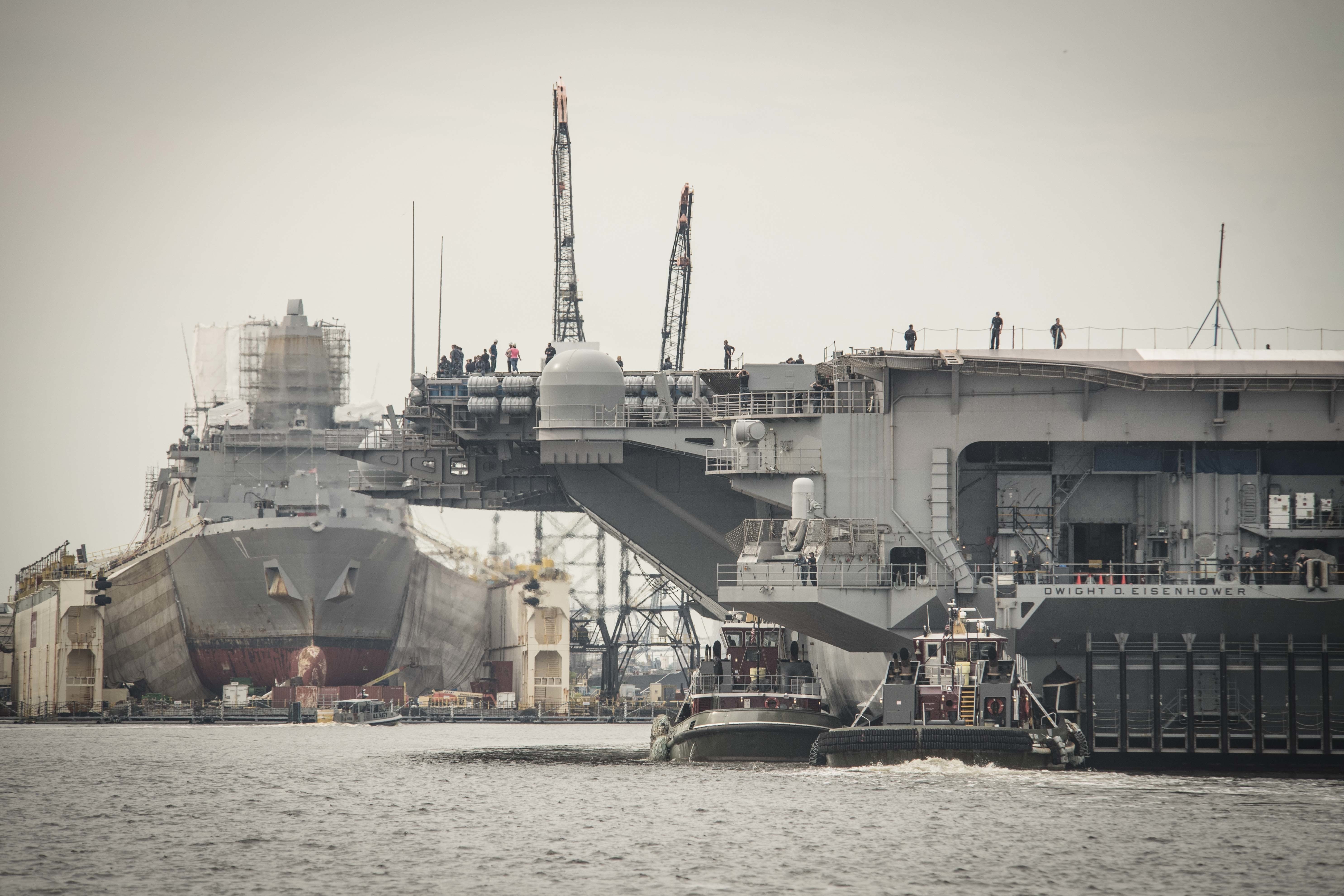
The Navy this month will explain to Congress what it needs to keep its ship repair yards able and optimized to maintain modern warships.
A congressionally mandated naval shipyard optimization plan is due to the Hill this month, Navy maintenance leadership has told USNI News, with a companion plan regarding private shipyard investments also in the works by the service.
Commander of Naval Sea Systems Command Vice Adm. Tom Moore told USNI News in a December interview that the plan for the four public naval shipyards would include a “fairly significant investment over the course of about 20 years, $10 billion-plus” that includes upgrades to the drydocks, a redesign of the yards’ layouts to optimize the flow of people and material, and new equipment to maintain and modernize 21st Century warships. Among the Navy’s challenges is that the oldest yard, Portsmouth Naval Shipyard , was built in 1800 and originally designed for ship construction; though the Navy has made piecemeal improvements over the decades, there hasn’t been a strategic, concerted effort to overhaul these public shipyards to meet the Navy’s current needs.
Some of these upgrades are needed as newer ships come into the fleet – the Virginia-class attack submarine with the Virginia Payload Module will not fit in all the naval shipyards’ drydocks, for example – but Moore also noted that if the Navy hopes to sustain a 355-ship fleet it needs to begin making investments to improve the yards’ output now.
Though not required by Congress, Moore said a hard look at the private repair yards was also necessary to support a 355-ship fleet, which can only be achieved in the near-term through service life extension programs (SLEPs) for many surface ships – work that would likely be done exclusively at private yards. Additionally, as more even-variant Littoral Combat Ships come into the fleet and begin operations out of San Diego, drydocks on the West Coast will be even more in-demand, as those Independence-variant LCSs require a drydock for nearly all their maintenance availabilities.
“If you’re going to talk about a meaningful SLEP program then I think we also have to turn our attention to the private sector and say, what does the private sector equivalent look like to this naval shipyard optimization plan? What does the private sector need in terms of drydocks and capacity and productivity improvements to manage the work we would demand out of them if we were going to go keep these ships longer?” Moore said.
“So there’s a private sector equivalent which we haven’t done as much work on,” he noted in December, saying that NAVSEA would be holding meetings with industry in the coming months to inform this private yard plan.
Director of Fleet Maintenance at U.S. Fleet Forces Command Rear Adm. Mark Whitney and Commander of Navy Regional Maintenance Center Rear Adm. Jim Downey both spoke recently of the need to view both efforts – on the private and public yard sides – as an integrated look at what the Navy’s maintenance needs are going forward and how to invest smartly to support those needs.
“Over the course of decades and decades, we accumulated risk in our infrastructure,” Whitney said at the Surface Navy Association’s annual symposium in January.
“We’re now at the point where we’ve gotten a little bit more sophisticated, we’ve culled the data, and I think [NAVSEA’s maintenance and industry operations division] has put together a very credible argument on the need to make decisions now and over the foreseeable future, that if we do not make decisions we start to lose the capability to do a type of ship in a drydock in this year, and it just starts to accumulate. So now is the time to articulate that and present that in terms of risk to senior decision-makers.”
“Following closely behind that … there’s a private sector piece that has to be a companion and integrated together,” Whitney continued.
“So there’s going to be two companion products, and it’s a holistic approach from the operator to communicate with senior leadership what the risks are,” Whitney continued.
Downey, who also serves as the deputy commander of NAVSEA for surface warfare, said at the SNA symposium that routine maintenance as well as upcoming SLEP efforts would put a “relatively significant demand signal on docks” in major fleet concentration areas like Norfolk and San Diego and also in places like the Pacific Northwest and in Mayport, Fla.
Downey said the private shipyard optimization plan would be crafted in the coming months “taking into account what we’re doing on the public yard side,” but that a clear takeaway already is that “you can quickly go to, we need more docks.”
“Part of that, though, also becomes, what has happened to the docking duration? What’s happened to Navy oversight activity and industry’s activity during the dock duration, and how do we solicit docking-related avails in a more efficient way to allow industry to propose if they could double-dock ships,” he said.
“The private part is different than the public; it doesn’t mean the Navy’s necessarily going to request funds to go buy docks out in the private sector. We might be improving some docks – like out at 32nd Street ( in San Diego) to modify that graving dock to handle a DDG with the sonar dome issues – but we obviously want to get to the incentive and cost-sharing approach [that] industry is interested in across the nation. To do that, we realize the most important thing is probably predictable, forecastable work.”





